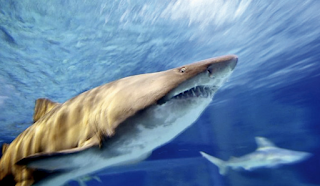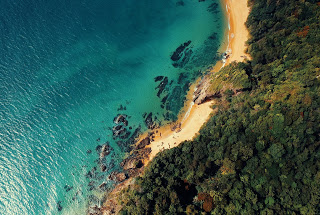Sharks threatened by global fisheries, How climate change created a drug-resistant fungus, Bi-partisan carbon tax introduced in US, Glow-in-the-dark sharks, China’s waste crisis, New York’s commitment to renewable energy and more…
1. New study finds commercial fishing threatens sharks worldwide
An international team of more than 150 scientists from 26 countries have collated movement data from nearly 2,000 sharks tracked with satellite transmitter tags. The groundbreaking study, published in the journal Nature reports, revealed that even the remotest parts of the ocean appear to offer highly migratory sharks little refuge from industrialized fishing fleets.
2. Drug-resistant fungus may be on the rise due to global warming
 Climate change may be causing a wide-spread, drug-resistant fungus, according to a study published recently in the American Society for Microbiology. Researchers found that the new fungal disease could be the first to emerge as a result of climate change. The Centers for Disease Control and Prevention (CDC) confirmed 587 cases of the fungus, Candida auris, in March. The CDC had said it was resistant to antifungal drugs.
Climate change may be causing a wide-spread, drug-resistant fungus, according to a study published recently in the American Society for Microbiology. Researchers found that the new fungal disease could be the first to emerge as a result of climate change. The Centers for Disease Control and Prevention (CDC) confirmed 587 cases of the fungus, Candida auris, in March. The CDC had said it was resistant to antifungal drugs.
 Members of Congress on both sides of the aisle are introducing competing bills that aim to put a tax on carbon. The push to regulate greenhouse gas emissions come as both Democrats and Republicans face pressure from their constituents, and in some cases, the fossil fuel industry itself, to regulate carbon emissions that lead to climate change.
Members of Congress on both sides of the aisle are introducing competing bills that aim to put a tax on carbon. The push to regulate greenhouse gas emissions come as both Democrats and Republicans face pressure from their constituents, and in some cases, the fossil fuel industry itself, to regulate carbon emissions that lead to climate change.
4. Scientists discover a new species of tiny sharks that glow in the dark
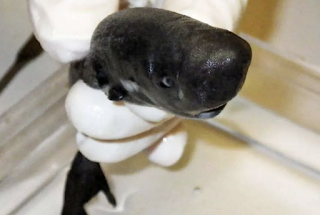 Scientists have identified a new species of tiny shark that secretes a glow-in-the-dark liquid. The 5.5-inch specimen — dubbed the American Pocket Shark, or Mollisquama mississippiensis — was first discovered in 2010 in the Gulf of Mexico during a National Oceanic and Atmospheric Administration (NOAA) mission to study sperm whale feeding. In a recent study, researchers identified its species by using a dissecting microscope and studying radiographic (x-ray) images and high-resolution CT scans.
Scientists have identified a new species of tiny shark that secretes a glow-in-the-dark liquid. The 5.5-inch specimen — dubbed the American Pocket Shark, or Mollisquama mississippiensis — was first discovered in 2010 in the Gulf of Mexico during a National Oceanic and Atmospheric Administration (NOAA) mission to study sperm whale feeding. In a recent study, researchers identified its species by using a dissecting microscope and studying radiographic (x-ray) images and high-resolution CT scans.
———————————————–
5. Trump campaign is selling “Trump” branded plastic straws to raise funds and conservation ire.
 The Trump campaign has sold out of “Trump” branded plastic straws. When asked about this Trump stated, “We have bigger problems than plastic straws.” Trump was asked as he departed the White House if he is in favor of banning plastic straws. The question came as his campaign began selling plastic straws in response to growing bans on the items among local governments and businesses for environmental reasons.
The Trump campaign has sold out of “Trump” branded plastic straws. When asked about this Trump stated, “We have bigger problems than plastic straws.” Trump was asked as he departed the White House if he is in favor of banning plastic straws. The question came as his campaign began selling plastic straws in response to growing bans on the items among local governments and businesses for environmental reasons.
Read more from “The Hill”
———————————————–

The Chinese government is trying to get a nationwide waste crisis under control. The separated refuse will now be monitored by a paid government employee. He or she will check the separated refuse. Black bins are for “dry” stuff, brown for “wet,” blue for “recyclable” and red for “hazardous.” Sorting waste into these categories became mandatory in the city on July 1. There’s a penalty of 200 yuan ($30) for anyone who does not comply.
———————————————–
7. Shell shocked: the effects of ocean acidification
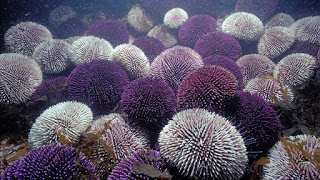 Marine ecosystems could be thrown off balance.
Marine ecosystems could be thrown off balance.The world’s oceans are acidifying rapidly as they soak up massive amounts of carbon dioxide (CO2) released from burning fossil fuels. Scientists studying sea urchins have discovered an unexpected side effect of this acid brew—it can help some of them build thicker, stronger exoskeletons. These urchins could potentially overrun habitats.
8. Ocean snail is first animal officially endangered by deep-sea mining
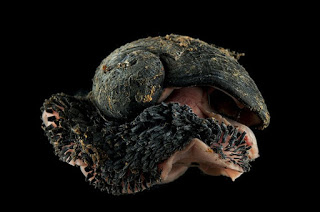
A snail that lives near hydrothermal vents on the ocean floor east of Madagascar has become the first deep-sea animal to be declared endangered because of the threat of mining. The International Union for Conservation of Nature (IUCN) added the scaly-foot snail (Chrysomallon squamiferum) to its Red List of endangered species on 18 July — amid a rush of companies applying for exploratory mining licenses.
———————————————-
The Maldives, known for their picturesque white, sandy beaches are confronting a large problem. According to UNICEF, the archipelago consumes huge amounts of plastic. According to the report, 280,000 plastic bottles are used and discarded daily in the capital city of Malé alone, and 104 million plastic bags were imported to the Maldives in 2018. National leadership has committed to reducing single-use plastic to zero by 2025
11. Tuna are spawning in marine protected areas
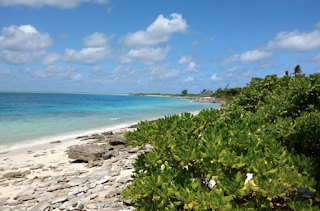
Marine protected areas are large swaths of coastal seas or open ocean that are protected by governments from activities such as commercial fishing and mining. Such marine sanctuaries have had rehabilitating effects on at-risk species living within their borders. But it’s been less clear how they benefit highly migratory species such as tuna. Now researchers at MIT and the Woods Hole Oceanographic Institution have found evidence that tuna are spawning in the Phoenix Islands Protected Area (PIPA), one of the largest marine protected areas in the world, covering an area of the central Pacific as large as Argentina.
12. Shark Week 2019 – Still committed to shark conservation
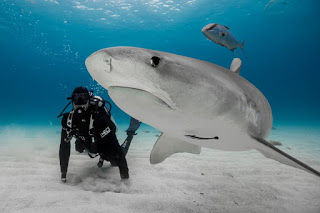 Sea Save Foundation director, Georgienne Bradley was one of the first “Shark Week Finbassadors”. The concept was that the successful week of programming draws so many shark aficionados, that it is an ideal time to talk about shark conservation. Sharks play an important role in the ecosystem by keeping the oceans in balance. Those involved with Discovery Channel’s annual Shark Week aim to dispel the fear associated with sharks. Shark Week, which airs July 28 through August 4, is not just entertainment, it’s also a tool to educate people on the importance of these majestic animals.
Sea Save Foundation director, Georgienne Bradley was one of the first “Shark Week Finbassadors”. The concept was that the successful week of programming draws so many shark aficionados, that it is an ideal time to talk about shark conservation. Sharks play an important role in the ecosystem by keeping the oceans in balance. Those involved with Discovery Channel’s annual Shark Week aim to dispel the fear associated with sharks. Shark Week, which airs July 28 through August 4, is not just entertainment, it’s also a tool to educate people on the importance of these majestic animals.Watch Discovery Video – Shark Finbassador Launch
13. New York ups commitment to renewable energy by awarding largest wind energy contracts
 New York officials said Thursday that the state would award the largest offshore wind energy contracts in the country as the state ups its commitment to renewable energy. Gov. Andrew Cuomo (D) signed an agreement for two offshore wind projects that, when completed, will provide a record nearly 1,700 megawatts to the city, officials announced. The New York government estimates that the project will create enough energy to power more than 1 million homes and result in 1,600 new jobs and $3.2 billion in economic activity.
New York officials said Thursday that the state would award the largest offshore wind energy contracts in the country as the state ups its commitment to renewable energy. Gov. Andrew Cuomo (D) signed an agreement for two offshore wind projects that, when completed, will provide a record nearly 1,700 megawatts to the city, officials announced. The New York government estimates that the project will create enough energy to power more than 1 million homes and result in 1,600 new jobs and $3.2 billion in economic activity.
The Department of Environment and Natural Resources (DENR) is inching closer to establishing networks of marine protected areas (MPAs) in a bid to boost the protection and conservation of some of the country’s coastal and marine ecosystems. So far, three areas have been identified with huge potential for the establishment of an MPA network. Establishing an MPA network will expand the MPA coverage in terms of area and strengthen protection and conservation by pooling together the limited resources of community-based organizations that manage the MPAs.
 The Space Race of the 1960s brought huge investment in space exploration. Today, we must explore and protect Earth’s final frontier, its oceans. While we navigate to distant worlds, we’ve neglected our own planet and our greatest shared resource — our ocean. While life on Earth depends on the ocean, we still know far too little about it. Federal funding for space exploration comes to about $20 billion annually, compared to an estimated $2 billion for ocean science — a factor of 10 to 1. We have better maps of the surface of the moon and Mars than we have of our own seafloor, and more people have walked on the surface of the moon than have visited the deepest depths of the ocean.
The Space Race of the 1960s brought huge investment in space exploration. Today, we must explore and protect Earth’s final frontier, its oceans. While we navigate to distant worlds, we’ve neglected our own planet and our greatest shared resource — our ocean. While life on Earth depends on the ocean, we still know far too little about it. Federal funding for space exploration comes to about $20 billion annually, compared to an estimated $2 billion for ocean science — a factor of 10 to 1. We have better maps of the surface of the moon and Mars than we have of our own seafloor, and more people have walked on the surface of the moon than have visited the deepest depths of the ocean.
Sea Save Foundation is committed to raising awareness of marine conservation. The Ocean Week in Review is a team effort produced by the Sea Save staff to provide a weekly summary of the latest in marine research, policy, and news

